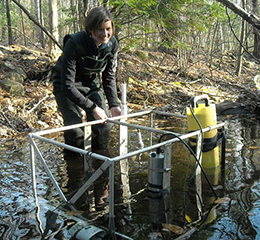
Allison Price from WSAG deploys an in situ sensor suite in a small headwater stream at Saddleback Mountain in Northwood, NH where the Lamprey River originates, as part of a research project funded through NOAA and the NH Sea Grant. [full story].
Research Projects
2022-2024 NH-AES CREATE:
An On-the-go Sensor to Enable Low-cost, In-situ and Rapid Measurements of Deep Soil Carbon/Nitrogen. (PI Shaad Mahmud in CEPS) $50,000
2022-2023 Friend of Big Island Pond:
Impact of Shoreline Development on Water Quality Throughout Big Island Pond. $16,948.
2022-2028 NSF:
LTER: Plum Island Ecosystems, the impact of changing landscapes and climate on interconnected coastal ecosystems. $468,531. (UNH Portion, PI: A. Giblin @ MBL).
2022 Ocean Conservancy:
Tracking plastic bottle through river systems. $103,814.
2021-2022 DOE-FICUS:
Assessing the contribution of sediment bioirrigation to the oxidative removal of methane from a fluvial wetland. (w/ PI Emil Ruff, MBL) $0 (Budget is for analysis at DOE labs)
2021 AES Equipment Grant:
Enhanced Carbon and Nitrogen Cycle Research for Hatch with Elementar Elemental Analyzer (w/ co-PI W.M. McDowell)
2021-2023 NOAA, Seagrant, Long Island Sound Study:
Can Watershed Land Use Legacies Inform Nitrogen Management? $129,954
2021-2024 NSF-Hydrology:
Collaborative Proposal: Plastic Spiraling In River Networks (Plastic-SIReN): Determining the controls of watershed plastic fluxes using a field and modeling approach. $429,900.
2020-2023 New Hampshire AES:
The response of water quality and aquatic ecosystem function to changing land use and variable climate in New England. $20,000 per year.
2019 EPA Low Cost Nutrient Sensor Challenge – Phase 2
Quantifying the impact of dam removals on nitrate retention using low cost nitrate sensors. $50,000
2019-2022 NSF-Macrosystems Biology:
Collaborative Proposal: MSA:
Controls on coupled nitrogen & carbon cycles of watersheds across eco-regions. $219,588.
2019-2022 NSF-Macrosystems Biology:
Collaborative Proposal: MRA:
Linking land-to-water transport & stream carbon cycling to inform macrosystem carbon balance (Virginia Tech is lead). $176,653.
2019-2022 NSF-INFEWS: INFEWS/T2:
Identifying Sustainability Solutions through Global-Local-Global Analysis of a Coupled Water-Agriculture-Bioenergy System (Purdue University is lead). $820,000.
2016-2022 - NSF-LTER
LTER-Plum Island Ecosystems: Dynamics of a coastal ecosystem in a region of rapid climate change.
2016-2018 - EPA
Estimating Spatially Explicit Water Quality Benefits throughout River Systems: Development of Next Generation Stated Preference Methods Using National Probability Samples and Online Labor Pools. (Lead PI at UNH with Rob R. Johnston.).
2014-2017 - NH AES
Are all non-point sources created equally? Understanding the role of landscape heterogeneity and nutrient retention processes in agricultural and suburban lands of Sea Coast NH.
2013-2016 - NSF EPSCoR Track 2, with University of Maine
Collaborative Research: Strengthening the scientific basis for decision making: Advancing sustainability science and knowledge-action capacities in coupled coastal systems (w/J. Nisbet, PI).
2013-2015 - University of New Hampshire
Baseline quantification of the magnitude and timing of non-point nitrogen fluxes in the Oyster River and its impacted tributaties.
2012-2016 - NSF LTER
LTER-PIE: Interactions between External Drivers, Humans and Ecosystems in Shaping Ecological Process in a Mosaic of Coastal Landscapes and Estuarine Seascapes.
2012-2014 - NOAA NH SEAGRANT
Understanding the Mechanisms Controlling Storm Event Nitrogen Fluxes from the Lamprey River Watershed using Continuous in situ Sensors.
2012-2013 - NSF EPA ULTRA
EPA ULTRA Climate Project.
2011-2016 - NSF EPSCoR Track 1
Interaction Among Climate, Land Use, Ecosystem Services and Society.
2011-2014 - NH AES
Scaling the Impact of Agricultural Activity on Water Quality through Time and Space in the Great Bay Watershed.
2011-2015 - NSF Macrosystem Biology
Collaborative Research: Stream Consumers and Lotic Ecosystem Rates (SCALER): Scaling from Centimeters to Continents.
2011-2014 - NSF EaSM
Type 2: A Regional Earth System Model of the Northeast Corridor: Analyzing 21st Century Climate and Environment.
2010-2012 - NSF LTER
Plum Island Sound Comparative Ecosystem Study.
2010-2013 - EPA STAR
Consequences of Global Change on Water Quality: Impact of Climate Change and Variability on the Nation's Water Quality and Ecosystem State.
2009-2012 - NSF Chemical Oceanography
ETBC: Collaborative Research: Controls on the Flux, Age, and Composition of Terrestrial Organic Carbon Exported by Rivers to the Ocean.
2009-2012 - NSF CSAS
Collaborative Research: How Does Changing Seasonality Affect the Capacity of Arctic Stream Networks to Influence Nutrient Fluxes from the Landscape to the Ocean?
2009-2013 - NASA NEWS
Tracking Dissolved Organic Carbon and Its Absorption Characteristics Along the Aquatic Continuum Over Time Using a Remote Sensing Based Approach.
2007-2011 - NSF DEB-Coupled Human Natural Systems
Suburbanization, Water-Use, Nitrogen Cycling & Eutrophication in the 21st Century: Interactions, Feedbacks & Uncertainties in a Massachusetts Coastal Zone.
2006-2009 - NSF DEB-Ecosystems
Collaborative Research: Understanding the Scaling of N Cycle Controls Throughout a River Network.
2004-2010 - NSF LTER
Plum Island Sound Comparative Ecosystem Study.
Banner image: Alaskan Range (photo courtesy of Wikipedia).
